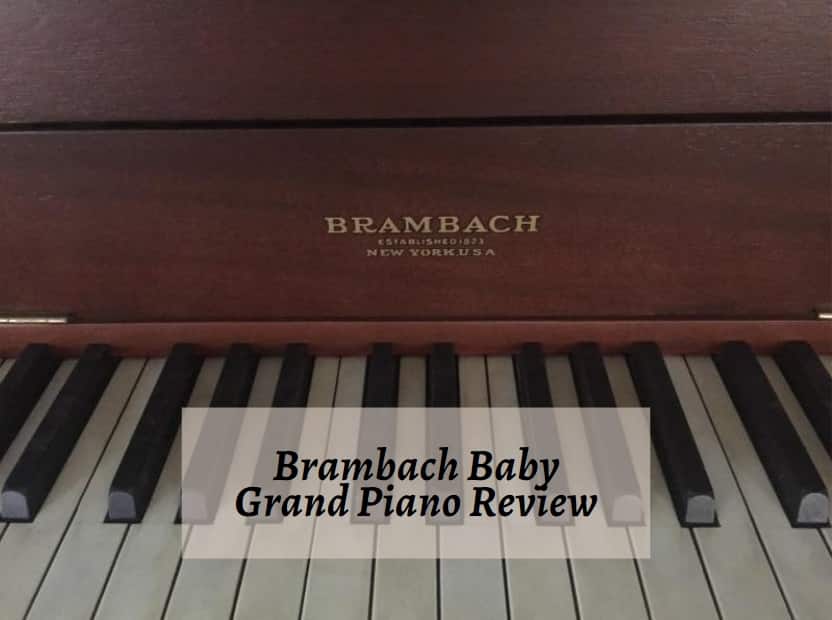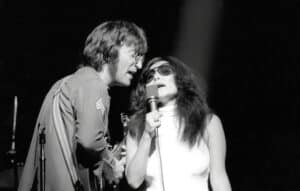
I thought I’d start the research on Brambach pianos in a slightly different way from the approach I’ve taken with other reviews, so I begin with some opinions on value.
What comes across from a considerable number of public comments is that the value of many of the instruments dating from the 1930s is negligible as they were not pianos that were built to last.
Others consider the Brambach to embody a piano of exquisite quality and outstanding reputation. As such it seems the price for an antique baby grand Brambach piano varies from as little as $500 to around $4000 for one that has been painstakingly restored.
Brambach Baby Grand Piano Review
One example of a Brambach Baby Grand piano for sale dates back a little while now but was manufactured in 1926 with a walnut cabinet. This 5’2″ piano was priced at $5,500 and claimed, according to the advertisement to be an instrument of character and quality.
The vendor extolls the virtues of the piano mentioning that it was the accumulation of years of experience and technological advances. They go on to say that in their opinion the Brambach Piano Company was “the embodiment of artistic grace and individuality of tone”.
From the early part of the 210th Century, there were a large number of piano manufacturers attempting to carve out their way in a developing market.
New York was the city of choice for the Brambach Piano Company which early on in its manufacturing claimed to be the only piano maker producing the world’s smallest grand piano.
From an article that dates from the early days of Brambach, several important details shed a clear light on the pianos made by the company.
Where Brambach cornered the market was in the manufacturing of a grand piano “at the price of a first-class upright”.
As pianos began to replace the reed organs from the previous century, it is easy to understand why Brambach may have chosen this marketing strategy and commercial focus.
An additional feature of the Brambach grand piano was that it would fit comfortably into a space no larger than that required by an upright piano.
The company was founded in 1823 by Franz Brambach. Up until around 1912 the company made upright pianos successfully however from 1912, the executive decision was taken to concentrate their efforts solely on the production of grand pianos.
This made the Brambach Company unique. These first pianos were a very modest four feet eight inches in size but this left the challenge of sound production. There was, after all, little point in producing a diminutive grand piano with the tonal qualities of an upright.
What Brambach devoted considerable time and recourses developing was their patented ‘Tone Expander’. This innovation was added to Brambach pianos alongside a custom-made soundboard that also included revolutionary new design ideas.
The ‘Tone Exapander’ was intended to have a dramatic effect on the overall sound quality and timbre of the piano. The Brambach Baby Grand had a ‘rich and mellow’ sound and with the addition of the ‘Tone Expander’, a potential volume to rival far larger, or full-sized grand pianos.
For buyers at the time, with modest finances and limited space, the Brambach grand presented a whole host of attractive possibilities.
Coupled with the abundance of these instruments, this angle ensured that Brambach pianos established a strong foothold in the US market that cannot have been easy to achieve given the competition.
The marketing strategies didn’t end there. Brambach, under the leadership of Vice-President Stephen Brambach, ensured that the company’s reputation was not only for making small grand pianos with a big sound but for manufacturing baby grand pianos with outstanding all-around qualities.
In a sense, this is perhaps where the criticism of Brambach has its roots. If you are manufacturing pianos at such a fast rate and in such large numbers, as they were, then can you be assured of their consistency in terms of build quality?
Brambach Piano Company made their own ‘actions’. Often piano manufacturers made cabinets, imported internal components, (often from Germany), and then out-sourced the design or manufacturing of the piano’s action.
Brambach prided themselves on not only having designed a ‘repeating action’ system but it was made at their factories. The brochures from this time clearly state that the components used in the manufacture of the action were imported but only components of the highest quality.
It was another potential plus point for the Brambach Piano Company but equally a claim that has been refuted by many critics of the pianos.
What does seem to be a commonality is that this ‘action’ referred to by the company was, compared to other piano manufacturers’ piano actions, more durable.
The Brambach ‘Baby’ Grand Piano came in three sizes that were the 4’8”; the 5’0” and the 5’5” versions. Each was reportedly made to the same high standard and based on decades of experience in piano manufacturing.
The ‘Tone Expander’ and new soundboard technology came as standard in these pianos. By the middle of the 20th Century, Brambach was essentially immersed in the far larger company known as ‘Kohler & Campbell’ (one of the most successful manufacturers of pianos in the USA).
This relationship flourished for a relatively brief time until, in 1957, the Brambach name was discontinued.
Brambach remains a name that surely has historic significance even though the manufacturing of the grand piano range has ceased over half a century ago.
Similar to many other piano makers based in the USA, founded in the mid-19th century, some adore these instruments and perhaps even more who have no kind words to say.
If you come across a Brambach Baby Grand you may find it to be exactly the instrument you are looking for, lovingly restored and a window back into the golden age of American piano manufacturing.
In today’s market and judged perhaps unfairly against contemporary technology, the Brambach Baby Grand falls quite short of the standards we as pianists may expect.
One final piece of the Brambach legacy worthy of mention is that John Lennon and Yoko Ono purchased a 1917, mahogany-cased Brambach Baby Grand for their private residence on Cold Spring Harbour, Long Island, New York.

Lennon is thought to have composed huge hit songs like ‘Woman’, ‘Beautiful Boy’ and ‘Starting Over’.

I just acquired a Brambach baby grand. The previous owner said that her parents bought the piano used in 1952. I have tuned pianos for years and have found tuning this piano to be strait forward with no surprises. In spite of this piano’s age, the sound is brilliant and it really does sing.
I have a 1920 Brambach Baby Grand 5′ 2″. It was restored in the 1960’s. I inherited it from a close friend. It was used a lot in a bar then by my personal friend before I acquired it in 2021. I spent some time repairing some small parts and tuning it. It plays really good and sound great. If you find one of these, I think it is worth fixing and using it.
Gary Cummins
Bagdad, AZ.
Do you know if a typical piano tuning company can do a tuneup on a Brambach Baby Grand? Wondering if the “tone expander” requires special expertise…
I recently acquired a 1915 baby grand. I have the serial number but cannot seem to locate any information about it. I am curious about quality type of wood, is it even a 1915? Is it worth anything? Etc.